The accumulation of heat units (Growing Degree Days (GDD) will soon begin to increase rapidly in New Jersey as we approach the early weeks of April. If past histories or present-day monitoring indicate the need for interventions, then the best control windows for numerous insect/mite pests are beginning to occur. The following is an incomplete listing of a handful of some of our early-season Christmas tree insect pests that may need to be scouted & possibly controlled. Those included in this blog are the European pine sawfly, Eastern spruce gall adelgid, Cooley spruce gall adelgid, Nantucket pine tip moth, Pales weevil, White pine aphid, & Pine bark adelgid.
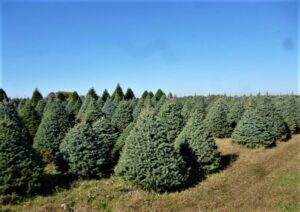
After many years, these slow growing Colorado blue spruce trees are close to reaching their peak selling growth stage as Christmas trees. (Photo Credit: Steven K. Rettke, Rutgers Coop. Ext.)
European Pine Sawflies: (Neodiprion sertifer) (35-135 GDD = Egg hatch):
The most common sawflies on pines are the European pine sawfly (EPS) and the redheaded pine sawfly (RPS). They commonly attack the two-needle pines (mugo pine, Scotch pine, and Japanese black pine). EPS overwinters as eggs in the needles, while RPS overwinters as pupae. EPS may soon begin to hatch, so monitor for the young larvae feeding on the needles. This sawfly will do most feeding during April. By May, most larvae will complete their 1-generation feeding damage for the year. RPS larvae will not be active until May after adults and the eggs they lay begin to hatch.
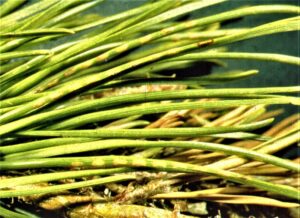
European pine sawfly eggs are inserted in rows along the length of pine needles. They have a yellow coloration. (Photo Credit: Ohio State Coop. Ext.)
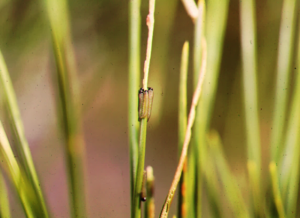
Early instar pine sawfly larvae feed together & partially consume the exterior tissues of pine needles. (Photo Credit: Steven K. Rettke, Rutgers Coop. Ext.)
When sawfly larvae are young, their mouthparts are small so they cannot initially eat the entire needle. Partial eating of the needles results in the remaining part curling, turning light brown & becoming straw-like. This appearance provides a highly effective monitoring tool, particularly on larger trees. The brown curled needles are easy to detect from a distance and indicate the presence of a cluster of sawflies feeding near that area. Large EPS populations are capable of completely defoliating large pines. When new candle growth begins to elongate, this sawfly has already dropped off the tree & moved into the pupation stage under the duff.
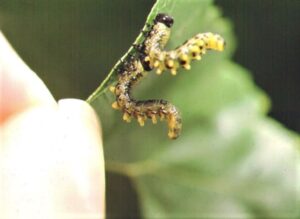
When in feeding clusters, late instar pine sawflies will perform a synchronized dancing movement when threatened by potential predators. (Photo Credit: Steven K. Rettke, Rutgers Coop. Ext.)
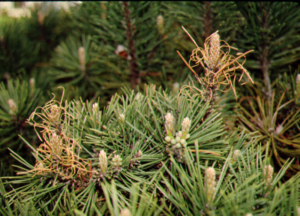
Pine sawfly larvae feed in clusters of a dozen or more. These groups will move from branch to branch feeding on needles & leaving straw-like symptoms. (Photo Credit: Steven K. Rettke, Rutgers Coop. Ext.)
Remember, sawfly larvae are wasps within the order Hymenoptera & are not caterpillars. Therefore, B.t. (Bacillus thuringiensis) will not control them. A 1% horticultural oil drench may control young larvae (not larger & older larvae). The uses of spinosad (Conserve), acephate (Orthene), carbaryl (Sevin), or any of the pyrethroids are some choices for the control of older larvae.
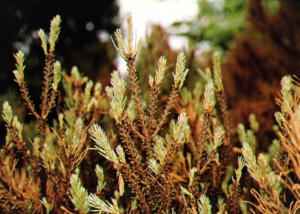
With large populations, virtually all needle growth from the previous past years can be defoliated. The branches shown only have the emerging new spring needle growth remaining. (Photo Credit: Steven K. Rettke, Rutgers Coop. Ext.)
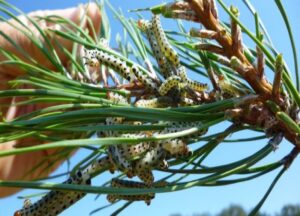
A population cluster of the red-headed pine sawflies. This species does not become active until the weeks of May after the European pine sawflies have finished feeding. (Photo Credit: Steven K. Rettke, Rutgers Coop. Ext.)
Eastern Spruce Gall Adelgids: (Adelges abietis) (22-91 GDD = nymphs/adults):
This spruce gall species forms at the base of the current year’s growth. The Eastern spruce gall adelgid (ESGA) is typically found on Norway spruce. Often the ESGA has the potential to be damaging to the aesthetic appearance of highly infested trees and can cause branch thinning & dieback. The other common spruce gall is the Cooley spruce gall adelgid which forms at the twig tip terminals & is primarily found on Colorado spruce.
The white, wax-covered, overwintering females, eggs & then nymphs are present at the base of buds on Norway spruce. The target to inspect for is small, white webbing located at the base of lateral buds (10X hand-lens might be useful). These are the protective sites where the adelgid stem mother will lay eggs within the webbing. Overwintering nymphs remain at the base of lateral branch buds waiting for stems to elongate.
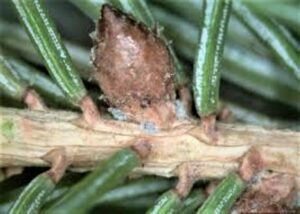
Overwintering Eastern spruce gall adelgid nymphs are present at the base of Norway spruce lateral branch buds. This is the target area for dormant oil sprays. (Photo Credit: Ohio State Coop. Ext.)

Young, green colored galls have formed at the base of newly expanding Norway spruce branches. Adelgid nymphs feed within chambers inside the galls. (Photo Credit: Steven K. Rettke, Rutgers Coop. Ext.)
Apply horticultural oil or insecticidal soap in April before the new bud shoots begin to swell and expand. Good results are achieved by targeting the females in late fall before eggs are laid or against nymphs in early spring with oils or soaps. Insecticidal soaps have dynamic controls against adelgids if good coverage is achieved.
Feeding nymphs will introduce a toxin within new expanding growth that eventually stimulates abnormal plant cell division and the formation of the protective galls. Once the green pineapple-like galls have formed at the base of new shoots during May, the only available control is to prune out and destroy the galls. Not even systemic insecticides will affect the nymphs within the galls.
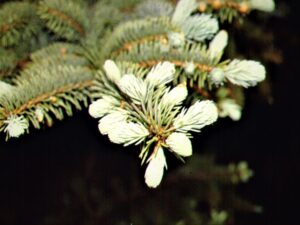
The control window has been missed once the lateral branch buds have opened & have begun to expand. (Photo Credit: Steven K. Rettke, Rutgers Coop. Ext.)
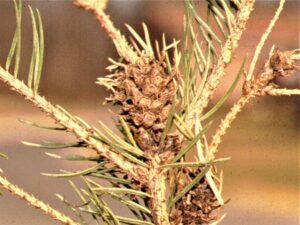
In late summer the adelgids mature & the galls open-up and turn brown. Galls can girdle branches & cause branch die-back. (Photo Credit: Steven K. Rettke, Rutgers Coop. Ext.)
Cooley Spruce Gall Adelgid: (Adelges cooleyi) (25-120 GDD)
The nymphs of the native Cooley spruce gall adelgid (CSGA) overwinters on Colorado spruce (especially the green forms) at the terminal bud tips. They will migrate to new growth as the twigs begin to elongate. The combined feeding and salivary secretions induce the development of a bright green, oval “pineapple” gall on the branch terminal tips (as opposed to galls from Eastern spruce gall adelgid that are at the base of new growth on Norway spruce). During June, the green-colored galls may grow to two inches in size. By midsummer, the gall will turn brown and crack open, as the mature adelgids emerge as adults. The CSGA winged adults will then migrate to Douglas fir (or another spruce) and spend the summer feeding on the needles. The pruning out and disposing of the “pineapple” shaped galls before they open in July is relatively easy & can provide effective physical controls. Once the galls have opened they will no longer be of concern. For aesthetic reasons, they can be easily removed by hand.
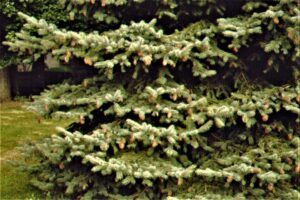
Colorado spruce are most susceptible to infestations by the Cooley spruce gall adelgid. The pineapple shaped galls form at the terminal tips of present season growth. (Photo Credit: Steven K. Rettke, Rutgers Coop. Ext.)
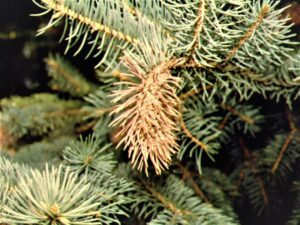
During mid-summer the galls on Colorado spruce will turn brown & open-up. Emerging adults will fly & migrate to a Douglas-fir or another spruce. (Photo Credit: Steven K. Rettke, Rutgers Coop. Ext.)
The CSGA has a complex multigenerational life cycle. Douglas fir is the alternate host & will often be found growing nearby. They feed on the needles of Douglas-fir for the summer before a percentage will fly back to spruce, where they will overwinter. Feeding causes the needles on Douglas-fir to become discolored, bent, and misshapen, however, galls are not produced. Individual tufts of wax (“cotton”) are noticeable on individual needles protecting the adelgid. This pest may go unnoticed in the landscape when infestations are light. Christmas tree growers will treat Douglas fir during the spring when the new growth is 3-4 inches in length. By the next fall, another winged generation flies back to spruce and lays eggs for the complicated life cycle to repeat itself. The CSGA has one of the most complex & confusing life cycles of any of our key insect pests. Blue forms of Douglas-firs are more susceptible to attack than green forms.
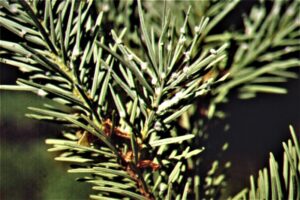
Cooley spruce gall adelgids on Douglas-fir (alternate host) will feed on needles within individual tufts of protective waxy cotton. (Photo Credit: Steven K. Rettke, Rutgers Coop. Ext.)
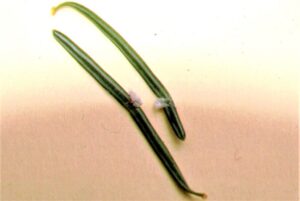
Adelgid nymphs within protective cottony wax feeding on Douglas-fir needle. (Photo Credit: Steven K. Rettke, Rutgers Coop. Ext.)
The damage done to Douglas-firs from the Cooley Spruce Gall Adelgid (CSGA) is typically a major concern within nurseries, especially Christmas tree farms. The distortion and white webbing on infested needles of the Douglas-fir are aesthetically unacceptable to the buyer. Nevertheless, studies have shown that this pest does not affect the growth and vigor of the trees. Also, the feeding injury by the CSGA does not cause premature needle drop. In production settings, the appearance of the ornamentals to be sold is not critical until the year of sale. Therefore, it only becomes necessary to apply control materials against the CSGA until a season or two before the projected year of sale. Two seasons of undamaged needles will more than adequately mask the damage done to the inner foliage during previous years.
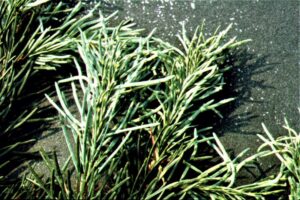
Douglas-fir needles have become twisted & distorted by feedings from Cooley spruce gall adelgid nymphs. (Photo Credit: Steven K. Rettke, Rutgers Coop. Ext.)
Controls:
Place sticky traps out in late summer (on Douglas-fir) (1850-1950 GDD) to determine the timing to spray adults with insecticidal soap (+ sticker). Future control windows will occur during the fall or early spring months, against the overwintering females located just beneath terminal bud tips. Acetamiprid is a reduced-risk material that is labeled for use on adelgids. Other possible treatments include horticultural oil, insecticidal soap, or carbaryl. Dormant oil sprays on spruce in early April (not blue forms) before stem elongation can control over-wintering nymphs. The systemics imidacloprid & dinotefuran are also labeled.
Nantucket Pine Tip Moth: (Rhyacionia frustrana) (121-448 GDD = 1st generation larvae):
The native Nantucket pine tip moth is a caterpillar pest that overwinters as brown-colored pupae within branch tips. With small trees & low populations, the tips containing the pupae can be pruned out before adults emerge next month. Pheromone traps will detect the initial emergence of the male moths. Adults in central NJ first emerge during mid to late April to lay their eggs on the tips of new growth of two and three-needle pines. Scotch pine is a common Christmas tree species that can be attacked. Newly hatched larvae feed in the needles first and then enter the buds and stems. This feeding causes the growing tips to turn brown & die back. Pines less than 6 feet tall that are growing in full sun will receive the most damage.
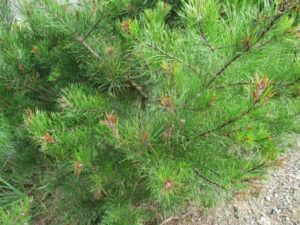
Nantucket pine tip moth is a wood boring caterpillar that feed in the terminal tips of pine branches. (Photo Credit: Steven K. Rettke, Rutgers Coop. Ext.)
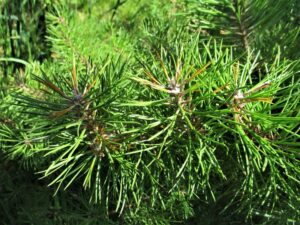
Early instar NPTM caterpillars will initially feed within needles before boring into the terminal branch tips. (Photo Credit: Steven K. Rettke, Rutgers Coop. Ext.)
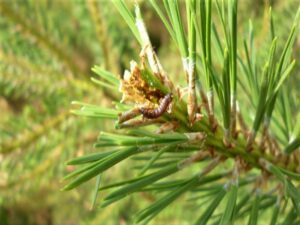
NPTM caterpillar larva dug-out from branch tip of this scrub pine. (Photo Credit: Steven K. Rettke, Rutgers Coop. Ext.)
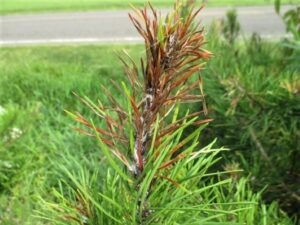
Terminal growth of this pine branch has been killed by the NPTM. The larval feedings act as a form of natural pruning. (Photo Credit: Steven K. Rettke, Rutgers Coop. Ext.)
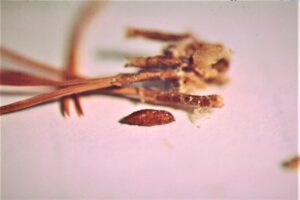
The NPTM pupal stage is virtually invulnerable to all insecticides. However. if timing is right, they can be pruned-out before they emerge as egg-laying adult moths. This pest has 2-generations per year & adult moths emerge in April & July in NJ. (Photo Credit: Steven K. Rettke, Rutgers Coop. Ext.)
For small populations, prune out the dying tips and destroy. For larger populations, hang out the pheromone traps to monitor for the adult flight period. Adults are ¼ inch long or less & have gray wings that are mottled with rust-colored patches. When the first moth is caught, wait 10 to 14 days before applying controls. Spinosad is a reduced-risk insecticide that is labeled for use in Christmas tree farms. Traditional control materials include acephate & the pyrethroids cyfluthrin or fluvalinate. The systemic imidacloprid is effective when proper lead time is provided (4 to 8 weeks with soil injections or drenches). Imidacloprid is usually not effective against caterpillars (i.e., therefore the NPTM is an exception to the rule). Be prepared for a second generation in July.
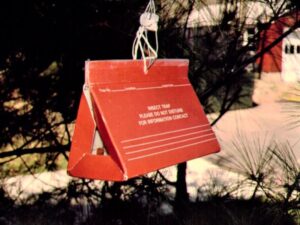
A pheromone baited delta-trap is designed to effectively capture adult Nantucket pine tip moths. (Photo Credit: Steven K. Rettke, Rutgers Coop. Ext.)
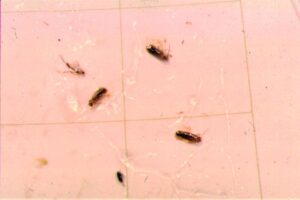
3-captured adult Nantucket pine tip moths in a delta trap. They are only 1/4 inch or less in size. (Photo Credit: Steven K. Rettke, Rutgers Coop. Ext.)
Pales Weevil: (Hylobius pales) (7-121 GDD)
The native Pales weevil is a conifer weevil that prefers to feed on the tender bark of seedling white pine and other conifers up to 18 inches tall. Occasionally they can be found feeding on spruce & Douglas-fir. The night-feeding adult weevils may also infest smaller twigs of larger pines, creating holes in the bark, girdled twigs, and dead needles. These insects are attracted to freshly cut pine stumps and sawdust and are considered a serious pest of young pines, especially in nurseries and Christmas tree farms. They are only occasionally a problem in the landscape because they need dead stumps or recently killed trees to perpetuate their life cycle.
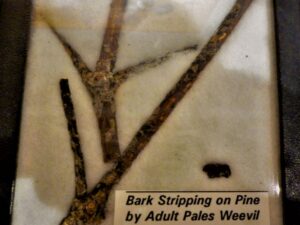
The adult Pales weevil can first become active in late March or early April in NJ. Adults feed on bark of branches. They can potentially girdle stems by stripping the bark & causing die-back. (Photo of UMD insect mounting display)
Adults overwinter in duff under pines and become active in March/April to feed on the bark of branches. The small, chewed areas create wounds that cause a flow of clear sap. This sap eventually crystallizes into a hard white substance and is usually the first symptom of Pales weevil feeding activity. Eggs are laid on stumps during April/May and larvae feed under the bark during the summer. There is one generation a year. New adults emerge during September & will feed briefly before overwintering in the duff under conifers.
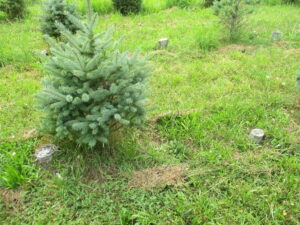
Recently cut stumps in Christmas tree farms can act as a potential breeding ground for larvae of Pales weevil. (Photo Credit: Steven K. Rettke, Rutgers Coop. Ext.)
Setting out freshly cut pine blocks can monitor adult weevil activity. The adults are attracted to these blocks and will hide beneath them during the day. Applications of long residual materials such as pyrethroids & carbaryl to the branches of infested trees can control the feeding by adults. Treat the branches in the spring (April) & then again in early fall (September). The removal of dead trees and stumps is an important sanitation practice. Otherwise, to suppress larvae, treat stumps with a residual insecticide in March & April for two consecutive years to reduce future damage.
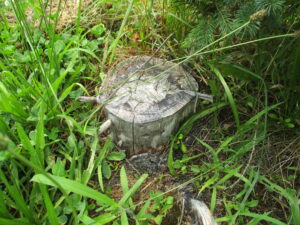
Adult Pales weevils will emerge in early spring & lay eggs within freshly cut stumps. The larvae feed under the bark of stumps. The photo shows a older stump with bark removed & therefore will not be selected by the adults to lay eggs. (Photo Credit: Steven K. Rettke, Rutgers Coop. Ext.)
White Pine Aphid: (Cinara strobi) (7-246 GDD = Pre & Post Egg Hatch):
This native aphid feeds only on eastern white pine. Overwintering oval black eggs laid in rows along the needle length is easily visible when monitoring. Adult aphids are large (3/16 inch) and brownish-black in color with long legs. Adults also have a central white stripe and white spots on each side of the abdomen. They suck phloem sap through the bark of branches and may cause some branch dieback if populations are high. Their presence is commonly discovered when aphid honeydew excrement turns the needles black with the sooty mold fungus growth. The sugary honeydew may also attract ants and swarms of hornets and yellowjackets (the latter two are good predators in the spring but become a nuisance in the early fall). Feeding aphid populations live in dense clusters on white pine twigs. There are several generations per year.
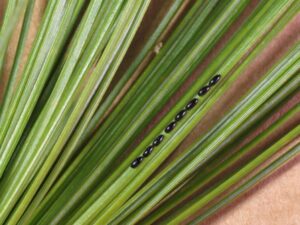
Black colored white pine aphid eggs are laid like a string of beads along the length of eastern white pine needles. (Photo Credit: North Carolina Coop. Ext.)

Adult white pine aphids feeding on bark into phloem of eastern white pine. Adults have a white stripe with spots along the sides of abdomen. The black sooty mold is growing on the honeydew exuded by the aphids. (Photo Credit: Unknown)
When numerous natural enemies are present, attempt to use less harmful controls. With good coverage, horticultural oil can be used to treat both overwintering eggs as well as nymph & adult aphids when heavy populations warrant control. Acetamiprid is a reduced-risk material that is labeled. Numerous insecticides are labeled for use against white pine aphids. Insecticidal soaps will typically only provide suppression against aphids & may not provide satisfactory results.
Pine Bark Adelgids: (Pineus strobi) (22-58 GDD)
These common aphid-like insects (they are adelgids) form a white, cottony coating on the bark of white pine and Scots pine. Immatures are presently overwintering on the bark. With heavy infestations, copious amounts of white wax can be found on trunks, branches & small twigs. Damage is usually cosmetic & light to moderate populations will not be a plant healthcare concern to infested pines. However, customers may react negatively to their presence.
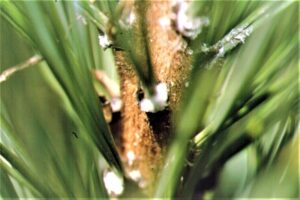
A relatively light population of pine bark adelgids. Photo shows adelgids feeding on bark at the base of white pine needles. (Photo Credit: Steven K. Rettke, Rutgers Coop. Ext.)
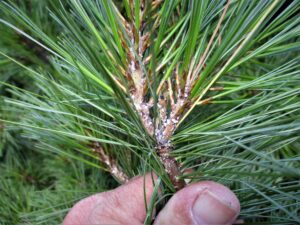
A moderate population of pine bark adelgids feeding on bark near the end of white pine branch. (Photo Credit: Steven K. Rettke, Rutgers Coop. Ext.)
Reduce the first of several generations of adelgids with a strong blast of water, horticultural oil, or insecticidal soap. Insecticidal soaps are highly effective in controlling adelgids. These treatments should help conserve beneficial insects such as flower fly maggots & lady beetle larvae that are commonly associated with this pest. They can often be found feeding on adelgids & their eggs under the white wax.
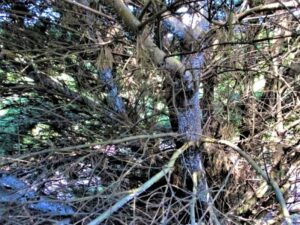
A heavy infestation of pine bark adelgids feeding on trunk of eastern white pine. (Photo Credit: Steven K. Rettke, Rutgers Coop. Ext.)
Reference: Managing Insects and Mites on Woody Plants: an IPM Approach, John A. Davidson & Michael J. Raupp, Bulletin 350, Maryland Cooperative Extension, 1999.

